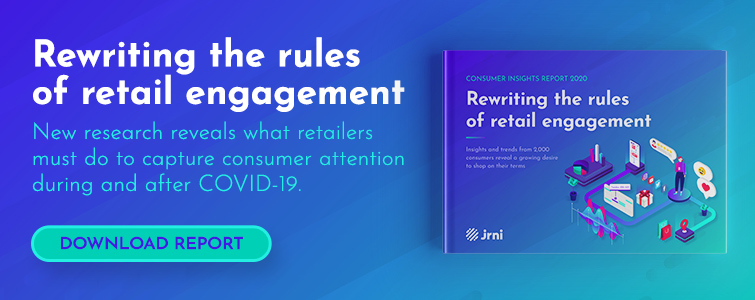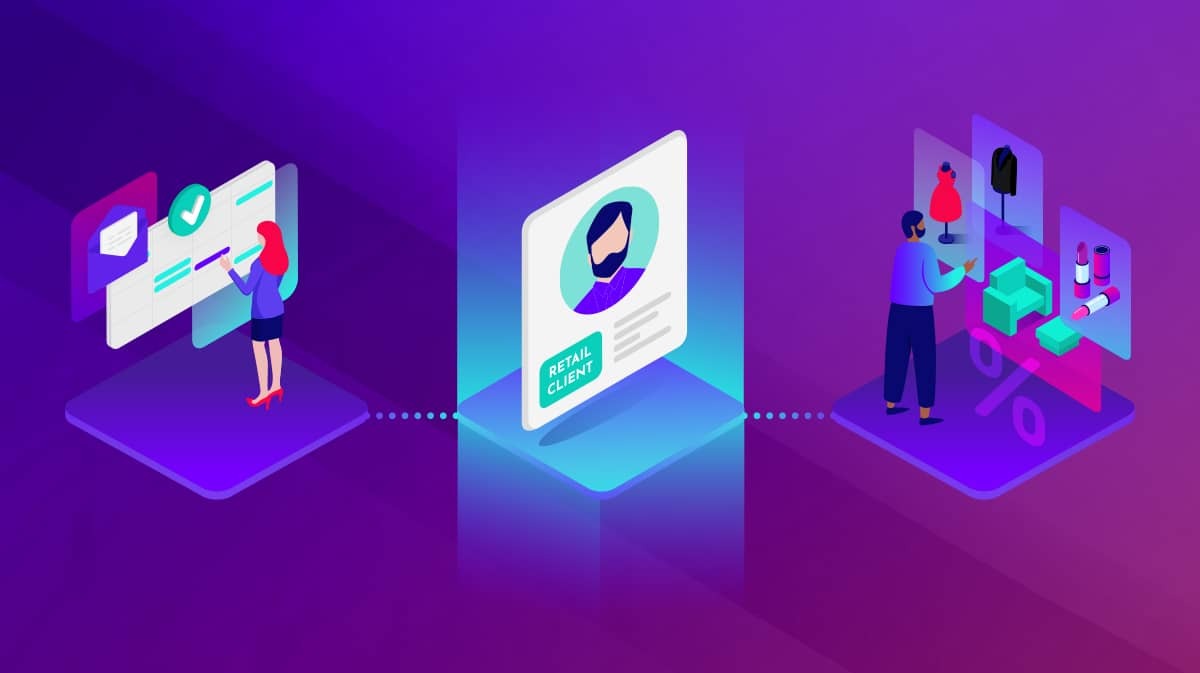(Editor's Note: This article was originally published in December 2016 and has recently been updated for accuracy and clarity)
Personalization is the act of tailoring an experience or communication based on information a company has learned about an individual. Just like you may tailor a gift for a good friend, companies can tailor experiences or communications based on information they've accumulated about their prospects and customers. Personalization in retail enables a retailer to gather everything they know about a customer and leverage it to provide an optimal and unique experience.
In this article, we’ll discuss the importance of a personalization in retail. Then we’ll look at how retailers can leverage technology and data to improve the customer experience and build customer loyalty.
Why personalization is important in retail
Today’s digital technology provides retailers with access to unprecedented amounts of data, which they can use to build a personalized and enhanced shopping experience. A data-driven experience allows retailers to engage with their clientele on a deeper level by guiding them through a customized conversion funnel. The result is often stronger customer relationships, increased loyalty and larger basket sizes.
Who retail personalization benefits
From a consumer’s perspective, personalization is beneficial because it (a) makes them feel that a brand values them and (b) helps them save time and money finding the products they want to buy. And who doesn't want to feel like every interaction was designed specifically for them?
The latter benefit is a consequence of the first, and here’s why: brands can show value by collecting and using descriptive, behavioral, interaction, and attitudinal data to create tailored conversion funnels for their customers. And these funnels help customers quickly and efficiently find the products they love.
On the flip side—from a retailer’s perspective—personalization is beneficial because customers who feel valued are more likely to stay loyal to a brand. Loyal customers engender more loyal customers through classic word-of-mouth advertising, generate higher customer lifetime value and build stronger customer retention. So, personalization in retail is purely win-win, benefiting both business and consumer.
How retailers can personalize experiences
It’s no secret that customer expectations are rising in an age of immediacy. The new generation seeks instant gratification, convenience, and real-time personalization and relevance whether they’re ordering from an online store or shopping in a physical one. So retailers must find ways to personalize across sales channels. In other words, it’s time to go “phygital.”
Launching tech-savvy stores
By combining the convenience of shopping online with the satisfaction of browsing store shelves, technology can create a cohesive online-offline—or phygital—customer experience. Plenty of companies are adding augmented reality, interactive touch screens, and other such technology to the sales floor to bridge the phygital divide.
Case study: Rebecca Minkoff
Rebecca Minkoff is bringing the best of online shopping in store, using cutting-edge technology to create a unique and unforgettable customer experience. Several of Minkoff’s luxury physical stores have augmented reality touch screens embedded in “magic mirrors.”
These allow customers to browse and style different products in interactive fitting rooms. Customers can click on items in their mirrors to notify retail associates that they would like to try the items on. They can then pay for items with their mobile phones.
Customer experience innovations, including radio frequency identification technology and interactive displays, are the main features of Rebecca Minkoff’s stores. The company also uses sensors and cameras to track customers inside its stores and uses the data to improve its store layouts, inventory, pricing, and window displays.
Here are two other retailers mastering the in-store experience alongside Rebecca Minkoff.
Enhancing the customer experience with data
Let’s take a step back for a moment and talk about data. Data plays a valuable role in relevance, a key ingredient to personalization. And whether your company is creating social media content, placing an ad, sending out an email marketing campaign, or extending in-store customer service, today’s consumers expect relevance.
In other words, consumers want their retail experiences to cater to their own needs, wants, and expectations, not those of others. And the more relevant the message, the better the chance of interaction.
Retailers can collect the data they need to inform relevance from the following sources:
- Mobile apps
- Online/in-store point-of-sale systems
- Order histories
- Help tickets
- Surveys
- Browsing data
- Web analytics
- Third-party data
- and more
These channels allow retailers to capture, store, and analyze information that can improve the way they design their customized conversion funnels.
Case study: Nordstrom
One of America’s most iconic fashion retailers, Nordstrom, is a leading brand using cutting-edge technology to personalize the consumer’s buying journey. The company has set up an Innovation Lab to learn how big data analytics can enhance the customer experience. This forward-thinking retailer is already trialing beacon technology to send customers personalized promotions and more from collated data on customer preferences and behaviors. It’s one of several companies using data to fuel personalized shopping experiences.

Data continued
Analytics can automatically track conversions and revenue, as well as identify seasonal trends and business patterns to inform future retail decisions. Data also provides a knowledge base that helps businesses understand how their customer service skills perform among a variety of channels, including on social media, through phone support, in one-to-one marketing, and in sales.
Companies can develop strong relationships with customers on the phone, through an email loyalty program, on social media, and on other electronic communication channels. Brands use these real-time personalization technologies and behavioral data to inform customers about upcoming events or relevant promotions they may be interested in or to ensure customer satisfaction on a recent purchase exchange.
Customer segmentation also uses data for unsupervised learning. A company can divide its customer base into different groups to deliver effective, personalized social media and marketing campaigns to valuable potential customers. This way, businesses can target specific customers with products and services tailored to meet their specific needs and goals.
Empowering staff with data for better customer service
Customer-focused retailers are recognized for their genuine commitment to delivering value to customers. A customer-centric culture focuses on providing positive customer experiences that drive loyalty and growth. Retail brands can leverage data to better understand their customers’ needs and desires and provide superior customer service.
Building a customer-centric culture starts with strong employee engagement and empowerment. Executives should empower employees at all levels, from the sales floor to the boardroom, to use data to inform and enhance customer satisfaction.
According to Red Ant CTO Dan Hartveld, “Smart retailers know that to drive customer engagement, service, and loyalty, customer service needs to be of the same standard, whether online or offline. Providing shop-floor workers with customer information, real-time company updates, and integrated communications across business divisions enables retailers to manage brand reputation, stock efficiencies, and customer experience more closely.”
For example, employees can analyze sales insights on a weekly or monthly basis to find out what products are most popular with customers. They can use these insights to guide future customers with more product information.
Product information arms employees with the tools they need to develop strong customer service skills. Employee empowerment and product knowledge boost employee engagement, confidence, and communication to engage with customers on a deeper level. By keeping product knowledge central to customer service, companies can further engage with individuals inside their physical stores, growing customer loyalty.
By arming staff with insight into a customer’s previous purchase history, browsing data, and even returns history, a retail associate can home in on that customer’s shopping preferences. Retailers can give their employees access to this data through analytics tools that provide valuable, easy-to-understand reports that break down purchasing trends and customer behavior.
Employee engagement defines an employee’s commitment to a company’s goals and business efforts. And consumer data gives employees insights to better assist their customers and in turn build stronger connections with their brands. Engaged employees can help lead retailers to success with strong customer loyalty and a high Net Promoter Score.
Furthermore, when employees are given the tools and real-time data to make customers happy, they will also feel more engaged and purpose driven at their job. Forbes recognized these brands’ service teams for providing gold-standard customer service.
Conclusion
Today’s consumers want a proactive customer service team and approach that identifies an authentic, prospering business. A proactive retail team that practices good customer service habits and delivers an unforgettable customer experience unveils a strong customer-centric culture that encourages customer loyalty.
Most importantly, customers are looking for a relationship and personalized experience with their service providers. Customer relationship management technologies are enabling businesses to extend relationships with customers beyond face-to-face interactions.
Want to learn more about what attracts and retains the consumers today? Then be sure to check out our recent research, "Rewriting the rules of retail engagement".




